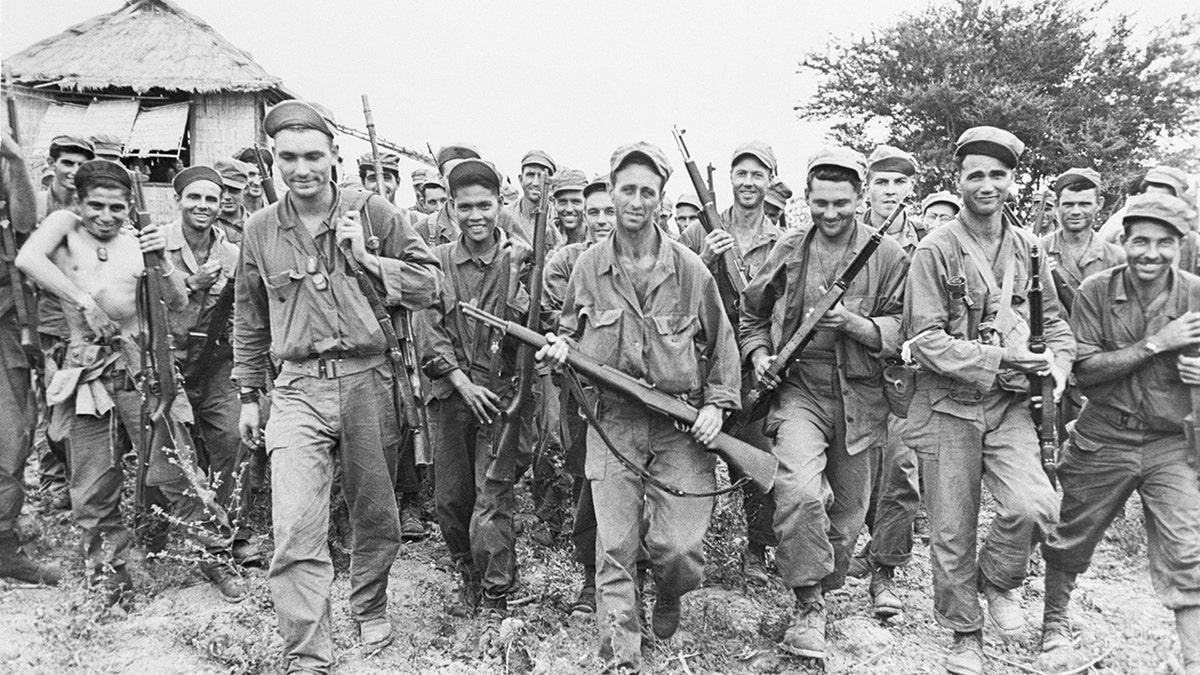‘Remarkable’ drone video puts a ‘human face’ to the war in Ukraine: Jack Carr
Former Navy SEAL sniper and ‘Terminal List’ author Jack Carr reacts to dramatic footage of a Russian soldier’s surrender as the war in Ukraine rages on.
On Jan. 30, 1945, the 6th Ranger Battalion led by Lt. Col. Henry Mucci, along with elements of the famed Alamo Scouts and Filipino guerrillas, conducted a raid on the Pangatian POW Camp just east of Cabanatuan City in the Philippines.
Three days earlier, American Guerrilla leader Maj. Robert Lapham had warned that in accordance with the Japanese War Ministry’s "kill-all order," the remaining Allied prisoners at Cabanatuan — many of whom were survivors of the Bataan Death March — would be executed before the island could be liberated.
Lapham cited the 139 American POWs executed at the Palawan POW camp on Dec. 14.
The Americans prepared a rescue mission.
The reconnaissance and assault force numbered 375.

Bestselling author Jack Carr (left), along with an image after the dramatic events of Jan. 30, 1945, involving the 6th Ranger Battalion. (Jack Carr/Getty Images)
One-hundred-and-twenty-eight of those individuals would conduct the actions on the objective, where there were believed to be 500 Japanese troops, though they later found there were approximately 225 on site.
In the surrounding five-mile radius, there were another 8,000 Japanese troops.
At 1945 (7:45 p.m.) on Jan. 30, 1945, the Rangers initiated the assault.
The OPORD for the rescue mission was a single page long.
Time was of the essence.
Armed with M1 Garands, Thompson submachine guns, BARs, 1911s and bazookas, the Rangers foot-patrolled 20 miles behind enemy lines to their target.

Shown are some of the Rangers of the U.S. 6th Ranger Battalion who participated in the daring commando raid on the Cabanatuan prison camp to release American and Filipino prisoners of Corregidor and Bataan, Jan. 1945. In the center, foreground, is Lieutenant John F. Murphy of Springfield, Massachusetts, and Notre Dame University, called one of the best officers among the Rangers and was one of the kingpins of the attack. (Getty Images)
At 1945 (7:45 p.m.) on Jan. 30, the Rangers initiated the assault.
The logbook for 6th Ranger Battalion for the following day, Jan. 31, 1945, simply reads: "Co ‘C’ and 2nd Platoon Co ‘F’ returned to Ranger Area. Mission Accomplished. Casualties: Capt. Fisher and Corporal Sweezy killed in action; Pvt Peters, Jack wounded. Enemy casualties estimated at 250 by the Rangers and 300 by the Guerrillas forces. 510 prisoners released from Japanese prison."
The number of rescued personnel would later be amended to 512.

Jack Carr, bestselling author, recalls the daring raid on Jan. 30, 1945, to free POWs held by the Japanese during the final year of World War II. Carr is a former Navy SEAL Task Unit commander and sniper with deployments to Afghanistan and Iraq. His upcoming nonfiction work, "Targeted: Beirut - The 1983 Marine Barracks Bombing: The Untold True Origin Story of the War on Terror," with co-author, military historian and Pulitzer Prize finalist James Scott, will be published in Oct. 2024. (Simon & Schuster)
For more information, please read "Ghost Soldiers" by Hampton Sides.
(Follow Jack Carr on Instagram at https://www.instagram.com/jackcarrusa.)
More about the daring rescue on Jan. 30, 1945
The 6th Ranger Battalion was active from Sept. 26, 1944, to Dec. 30, 1945.
When the Allied fleet landed at Lingayen Gulf on Luzon Island, the 6th Rangers "achieved legendary feats" — as they had done earlier as well — in fighting the Japanese during World War II, as the U.S. Army notes on its website.
JACK CARR'S TAKE ON ‘BLACK HAWK DOWN’ ON OCTOBER 3, 1993: ‘BOND SHARED BY BROTHERS IN BLOOD’
On Jan. 30, 1945, at Cabanatuan, the "6th Rangers pulled off a superb rescue of more than 500 Allied prisoners of war, survivors of the Bataan Death March," who were facing death in captivity.
The 6th Rangers had the assignment to "bring the prisoners out alive," according to multiple accounts.

Writes Carr about the events of Jan. 30, 1945, "The number of rescued personnel would later be amended to 512." ( Jack Carr)
"The rescuers departed on their mission at dusk to walk 30 miles to the prison camp, crawling the last mile on their stomachs," reported the website WWIIRangers.org, run by descendants of WWII Rangers.
"They arrived at the camp about daylight" on Jan. 30.
Exactly as planned and "right on schedule, a P-61 ‘Black Widow’ night fighter roared over the camp, drawing everyone’s eyes upward. The prisoners cheered and the guards froze, just as expected," noted the U.S. Army Special Operations History Office website.
With that distraction assisting a hugely complex operation, the Rangers "hit the camp and brought out 512 prisoners of war [and] killed about 200 enemy troops."
CLICK HERE TO SIGN UP FOR OUR LIFESTYLE NEWSLETTER
While some of the prisoners "were able to walk, others rode carabao carts provided by Filipinos, while Rangers carried some [of the men] like babies who were too emaciated to walk or ride," according to reports.
Eventually, ambulances arrived and took the men to an evacuation hospital.
CLICK HERE TO GET THE FOX NEWS APP
General MacArthur reportedly said after the raid, "No incident in this war has given me greater pleasure."
Fox News Digital staff contributed reporting.
For more Lifestyle articles, visit www.foxnews.com/lifestyle.


